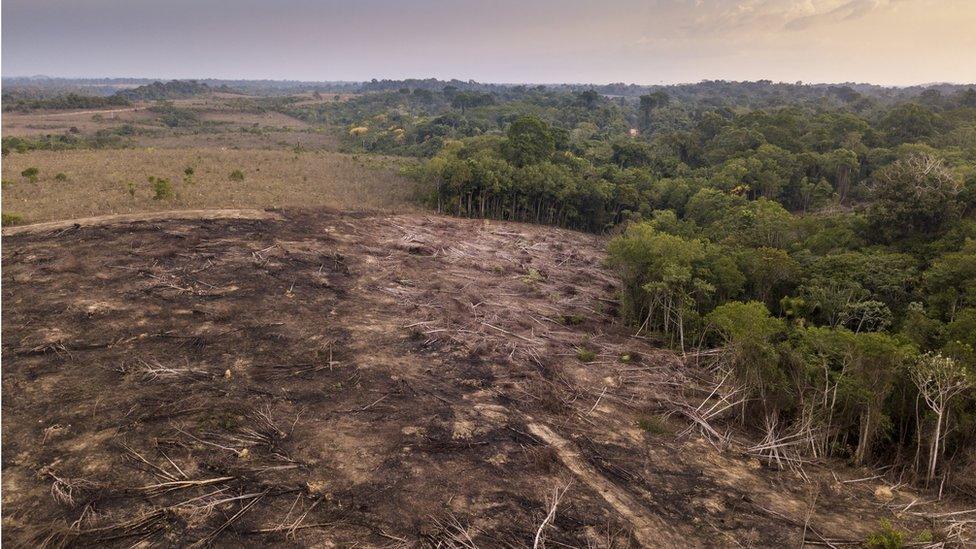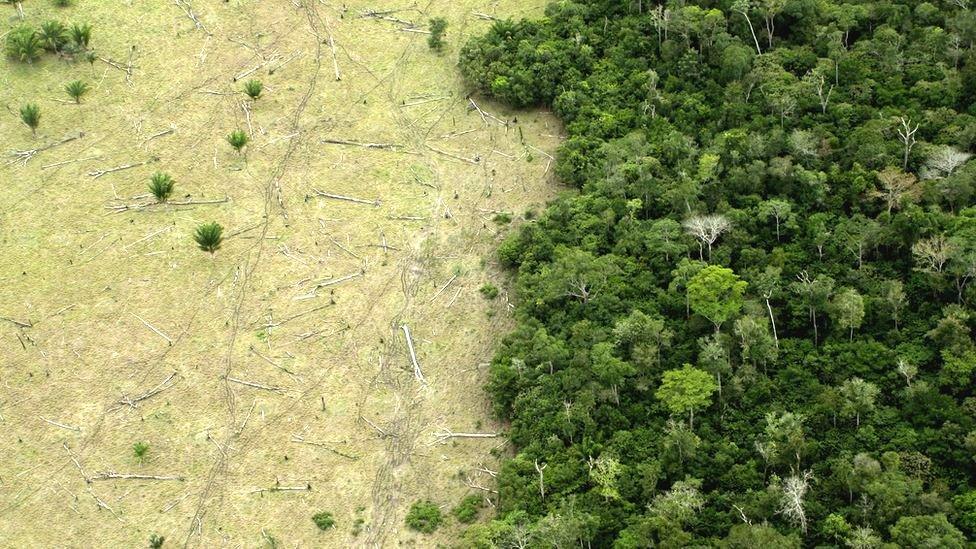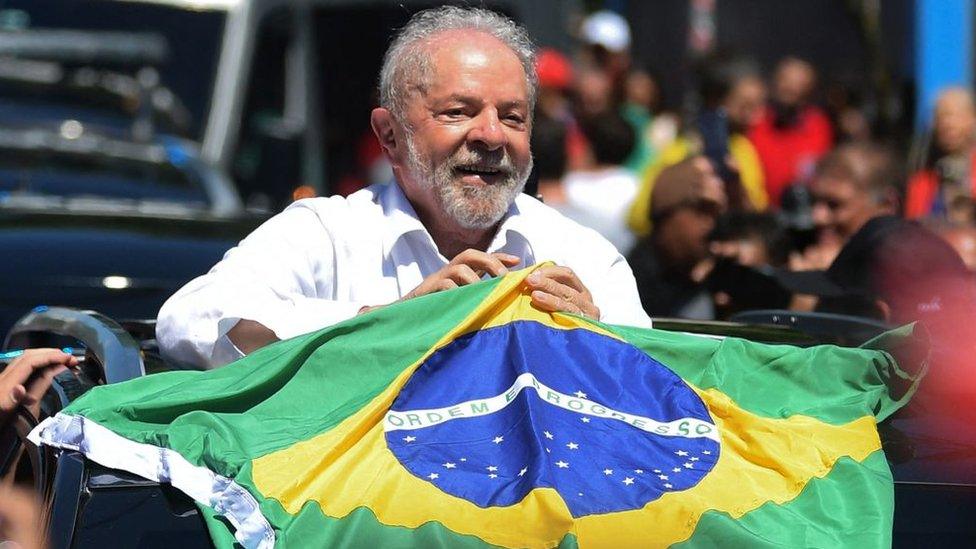Amazon: What's happening with the world's largest rainforest in Brazil?
- Published
- comments

Almost 60% of the Amazon rainforest is in Brazil
Brazil's new President has said he aims to make his country a "green superpower".
In his first speech, Luiz Inácio da Silva - known as Lula - promised to make climate protection a priority and explained he wanted to reach "zero deforestation" in the Amazon by 2030.
His election has brought hopes of more help to support the conservation of the Amazon rainforest after years of increasing deforestation.
But why is this important? Keep reading to find out.
What is the Amazon rainforest?

The Golden Lion Tamarin is an endangered species that is native to the Amazon rainforests of Brazil
The Amazon rainforest is the largest tropical rainforest in the world.
It is spread across nine countries in South America - Brazil, Peru, Columbia, Bolivia, Ecuador, French Guiana, Guyana, Suriname and Venezuela - but the majority of it, almost 60%, is in Brazil.
The huge rainforest is home to thousands of plants and wildlife species, many of which are only found in that part of the world.
It is also home to various species that are endangered and whose populations are under threat.
The Amazon rainforest is more than 24 times the size of the UK!
According to the conservation organisation World Wildlife Fund (WWF), the total known number of different species in the rainforest includes: 427 mammals, 1300 birds, 378 reptiles, over 400 amphibians and between 2,500 - 3,000 freshwater fish.
This large number is mainly due to the rainforest's warm temperatures and various ecosystems for wildlife and plants to live in.
Why is the Amazon rainforest important?

The Sumauma is one of the largest trees in the world - reaching up to 70 metres high - and can be found in the Amazon rainforest
The Amazon is very important in the world's fight against climate change.
Scientists often call the rainforest the "lungs of the planet" because of the role it plays in absorbing carbon dioxide and producing oxygen.
They say that preservation of the Amazon is vital to stopping climate change because of the large amount of carbon dioxide that the trees absorbs.
Brazil's Amazon rainforest is also home to around 900,000 Indigenous - or native - people, who live and rely on the rainforests.
Many of them fear their culture and survival is being threatened, as more and more trees are cut down to make way for farming and agriculture.
What are the main risks to those living in the Amazon?

Deforestation is a big issue in many countries aound the world including Brazil
Scientists say many of the changes to the Earth's climate are caused by human activity.
The Amazon has been under increasing pressure recently with Brazil setting a new deforestation record in 2022 for the amount of trees cut down in the rainforest in one month.
Trees are important for our environment for many reasons: they absorb carbon, fight flooding, reduce pollution and help wildlife.
Trees and plants take in carbon dioxide and release oxygen. When they're cut down, burned or left to rot, the carbon dioxide they store is released into the air and this contributes to something called global warming.
This happens when greenhouse gases trap heat from the Sun, causing the Earth to get hotter.
Deforestation is when forests are cleared for farmland, and the expansion of roads and cities, hunting of species and climate change - and all this has a negative impact on animal and plant species.
WATCH: What is life like for kids in the Amazon?
In the Amazon, the impact of deforestation has also felt directly by the Indigenous groups who have been living there for thousands of years.
They are among the most vulnerable to deforestation and fires, as they rely entirely on the forest to meet their needs for food, medicine and shelter.
Forest destruction can also push them from their homes and in some cases make it hard to continue with their way of life.
What is the Amazon's 'tipping point'?

The more trees cut down, the less the forest can soak up CO2 emissions
Last year, scientists said that the Amazon rainforest could reach a "tipping point" where its trees are unable to grow back, and the rainforest could be lost entirely.
A scientific study that used 30 years' worth of data found that a large amount of the trees in the Amazon are finding it harder to recover from damage caused by droughts, fires and deforestation.
This means that when trees are lost, new ones may not be able to grow back quickly enough in order to keep the rainforest intact.
This is what experts are calling a "tipping point", and if it was to happen, it could be really damaging to the environment.
However, scientists think that there's hope as the Amazon hasn't reached this point yet, and there are things people can do to make sure it never gets there.
Experts think that if deforestation is cut back, there's a chance of preventing the Amazon rainforest from reaching a point where the forest will never recover.
What has Brazil's new President Lula said?

Lula was sworn in as the new president of Brazil on 1 January 2023
Lula is a familiar face to voters, having been president before, from 2003 to 2010 but lost power in part because of claims about corruption and allegations that he hadn't been following the rules.
When he was in power previously his government managed to lower deforestation by around 80% so people will have high expectations that similar results could be achieved.
His predecessor, former President Jair Bolsonaro, had been accused of weakening environmental protection in Brazil during his time in office.
According to government data from the country, deforestation increased by 75% over the years under his Presidency.
But Mr Bolsonaro argued that allowing more farming and mining in the Amazon would reduce poverty in the region as it gives poorer people more opportunities.
In his first week as President, Lula has already reversed some of Mr Bolsonaro's environmental policies.
He restored the government's environmental protection agency and cancelled measures which allowed illegal mining on Indigenous lands.
He also picked an international Amazon campaigner, Marina Silva, as his new environment minister.
Lula also reopened the Amazon Fund, where foreign governments can help financially support the preservation of the rainforest.
